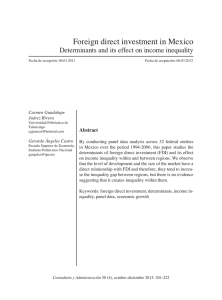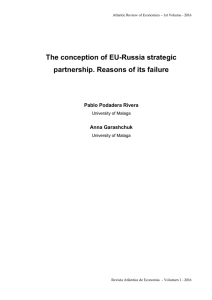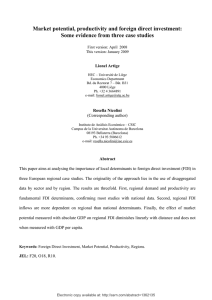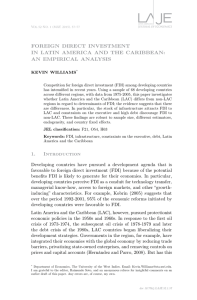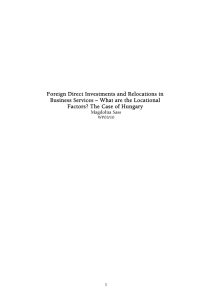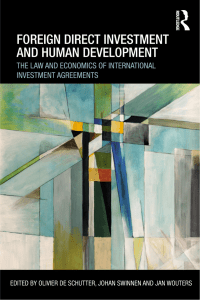Foreign Direct Investment and Economic Growth
Anuncio
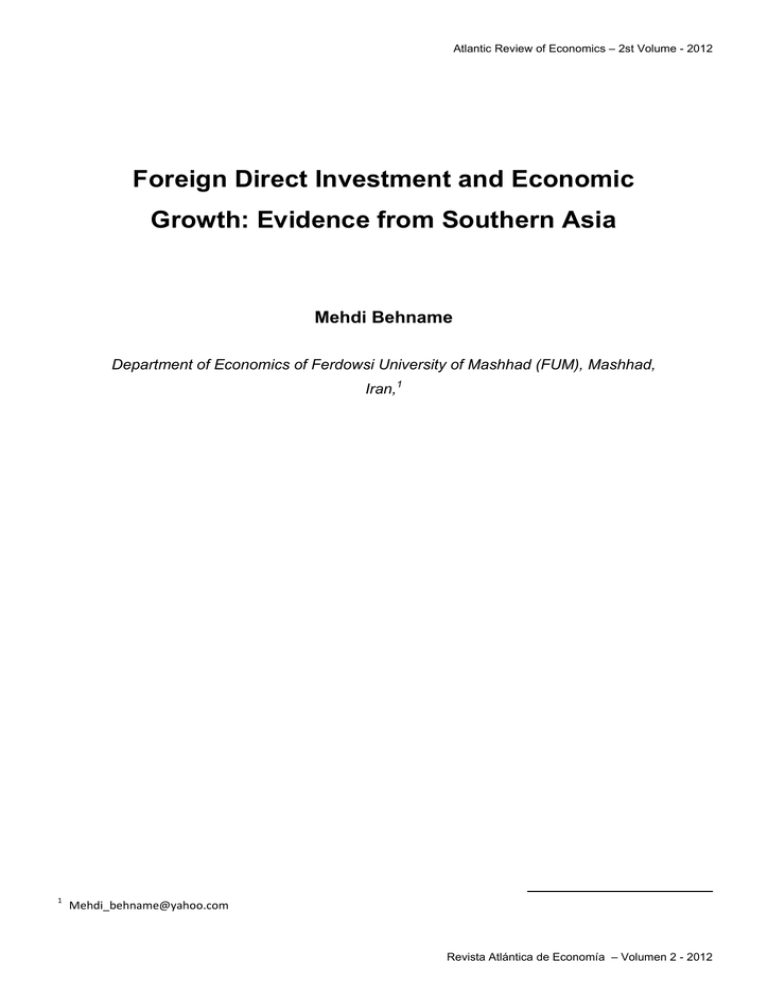
Atlantic Review of Economics – 2st Volume - 2012 Foreign Direct Investment and Economic Growth: Evidence from Southern Asia Mehdi Behname Department of Economics of Ferdowsi University of Mashhad (FUM), Mashhad, Iran,1 1 [email protected] Revista Atlántica de Economía – Volumen 2 - 2012 Atlantic Review of Economics – 2st Volume - 2012 Abstract The aim of this paper is to investigate the influence of foreign direct investment (FDI) on economic growth in Southern Asia for the period 1977-2009. The Im, Pesaran and Shin (2003) unit root test shows the variables are stationary in level and Hausman (1978) test proves that we should apply the random effects model. Having estimated the model we come to the conclusion that foreign direct investment (FDI) has positive and significant effect on economic growth and variables such as human capital, economic infrastructure and capital formation have positive effect on gross domestic product (GDP). But, population, technology gap and inflation have negative effect on the economic growth. Resumen El objetivo de este trabajo es investigar la influencia de la inversión extranjera directa (FDI) en el crecimiento económico en el sur de Asia para el período 1977-2009. La prueba de raíz unitaria de Im, Pesaran y Shin (2003) muestra que las variables son estacionarias a nivel y la prueba de Hausman (1978) demuestra que se debería aplicar el modelo de efectos aleatorios. Una vez estimado el modelo, llegamos a la conclusión de que la inversión extranjera directa (FDI) tiene un efecto positivo y significativo en el crecimiento económico; y variables tales como capital humano, infraestructura económica y formación de capital, tienen un efecto positivo sobre el producto interno bruto (PIB). Sin embargo, la población, la brecha tecnológica y la inflación tienen un efecto negativo sobre el crecimiento económico. JEL Classification: F21, F43 Keywords: Foreign Direct Investment; Economic Growth; Southern Asia; Panel Data Revista Atlántica de Economía – Volumen 2 - 2012 Atlantic Review of Economics – 2st Volume - 2012 1.- Introduction One of the main concerns of the governments is to promote development and welfare the country. In the past two decades, foreign direct investment (FDI) has been studied as an important factor for growth and development. In the recent years, Asian countries have attracted a significant part of the foreign direct investment (FDI) of the world. Beside on foreign direct investment (FDI) development, economic growth has been increased to 7.7% in Southern Asia in 2005, 13.8% in Pakistan, 8% in Afghanistan, 8% in Bhutan and 8% in India (World Bank 2006). The capital flow to Asian countries began in 1990 with an increasing rate following a decrease in 1980. The foreign direct investment (FDI) has been increased in Asian developing countries from 396 million dollars in 1980 to 102,066 million dollars in 2001. This rate is equal to 13.9% of foreign direct investment (FDI) of the world in 2001 (United Nations Conference on Trade and Development 2002). The World Bank reports showed the capital growth in Southern Asia to be 23.6 billion dollars in 2005. The major share of this growth belongs to India. In Pakistan, privatization and natural resources has caused the increase of foreign direct investment (FDI) which was 1.1 billion dollars in 2004 to 2.2 billion dollars in 2005 (United Nations Conference on Trade and Development 2006). This paper aims to show whether foreign direct investment (FDI) has had any share in the increase of economic growth in the south Asia or not. Borensztein and Gregorie & Lee (1978) proved that foreign direct investment (FDI) in an endogenous model provides the grounds for economic growth in developed countries. Blomstorm et al. (1996) asserted that foreign direct investment (FDI) provides economic growth in developing countries. But, Balasubramanyam et al. (1996) showed that foreign direct investment (FDI), plays more important role in economic growth as compared with export. Carkovic and Levine (2005) also showed that foreign direct investment (FDI) leads to the increase of economic performance. But, Gorg and Greenaway (2004) proved that foreign direct investment (FDI) does not have any influence on economic growth. 2.- Theoretical Basis Economic growth is one of the indices important to all countries of the world. And the countries devise many special plans and policies because increase of economic growth shows increase of social welfare and increase of the country’s economic development in long-term. In economics, many variables are effective on economic growth; for instance technology, physical Revista Atlántica de Economía – Volumen 2 - 2012 Atlantic Review of Economics – 2st Volume - 2012 capital, human capital, and so on. Meanwhile, foreign capital is one of the variables which bring the mentioned growth under its effect. Foreign investment may influence economic growth in two direct and indirect ways. Its direct effect is that foreign investment increases production, employment, added value and export. These factors directly increase GDP; for instance, employment increases the individual’s income and this income increment is directly calculated in GDP. Likewise is for added value and export. But, foreign investment increases GDP indirectly as well; for instance, transition of technology, knowledge and know-how through license, imitation and job training. Besides, externalities, technology spillover, human capital formation, efficiency and productivity are the factors which indirectly increase GDP in economic growth. Chakrabarti (2001) and Borensztein, De Gregorio, and Lee (1998) When the production technology is improved nationally the products would be supplied with higher quality and lower cost, and therefore, national production and per capita output would increase. In other words, technology is the potential source of productivity profits through spillover to domestic enterprises. Borensztein et al (1998) proved the difference in human capital in different countries influences attracting technology which finally would influence the economic growth. About the relationship between FDI and economic growth, it is believed in neoclassical economics that FDI only have effects on GDP per capita Yt/POPt and not on economic growth Yt – Y t 1 /Y t 1 . It means that FDI is not the economic growth engine in long term. In contrast, in the modern theory of economic growth it is believed that FDI affect production per capita and economic growth (Nuzhai Falki, 2008). Although many theories show that FDI results in economic growth through some factors such as transition of technology, technology spillover and increase of productivity, there are other theories which take opposite position. The later theories forecast that FDI is harmful to resource allocation at presence of preexisting trade, price and other financial disorders and it decreases economic growth (Boyd and Smith, 1992). This case is mostly observed in developing countries. But the main problem of such countries may be in their weak economic structure; for instance, improper infrastructures, weak human capital, traditional and old technology, and so on, which does not provide the ability required for attracting advanced technology and knowledge. 3.- Data and Methodology Before estimation of the model, we should be insured of the stationarity of variables. Dickey-Fuller, Augmented Dickey and Phillips-Perron tests are used to measure the stationarity of time series variables, however, for panel data which have higher power compared with time series, other tests are applied. These tests are: Im, Pasaran and Shin (2003), Levin, Lin and Chu (1992). Revista Atlántica de Economía – Volumen 2 - 2012 Atlantic Review of Economics – 2st Volume - 2012 Among different unit root tests in econometrics literature, the Levin, Lin and Chu (LLC) and Im, Pasaran and Shin (IPS) tests are more applied than others. Both of these tests have been made based on Augmented Dickey Fuller (ADF). If data are homogeneous, Levin, Lin and Chu (LLC) test has been made for dynamics of autoregressive coefficients for all panel parts. But, Im, Pasavan and Shin (IPS) test more considers heterogeneity of this dynamics. The benchmark model of autoregressive is as follows: Yit i Yit 1 i X it it (1) where shows i = 1,2,…N of the countries from the times of t=1,2,….,T. variables in the model. i is the autoregressive coefficient and it X it are exogenous is the static process. If i <1, Yi is weakly stationary and if i =1, then Yi has a unit root. In this paper, IPS test was used for the unit root, because the economic structures of the respective countries are different. Table 1.Unit root test and Panel data GDP INF -4.31* -3.21* POP -2.17* HU -5.68* INV -5.99* FDI -2.47* EX -3.16* The variables are stationary at the 5% confidence level. As defined in Table 1, all the variables were significant in 5% level. It means the variables are stationary, and so, spurious regression is avoided. Revista Atlántica de Economía – Volumen 2 - 2012 Atlantic Review of Economics – 2st Volume - 2012 4.- Data and methods Table 2. The list of variables Variables Sources Units Type of variable Expression used Gross domestic product (GDP) World GDP per capita per capita Development (constant 2000 indicators (WDI) US$) UNdata fixed telephone Infrastructure (INF) real Market size real Infrastructure annual % percentage Demand World GDP percentage Economic risk Development (annual %) real Education real Domestic and World lines (per 1,000 Development people) indicators (WDI) Population growth (POP) World Development indicators (WDI) Inflation (INFR) deflator indicators (WDI) and IMF Human capital (HU) World total number of Development pupils enrolled indicators (WDI) at and UNdata level in public secondary and private schools. Gross capital formation (INV) World constant 2000 Development US$ investment indicators (WDI) Foreign direct investment (FDI) UNCTAD net inflows real (BoP, constant FDI (dependent variable) 2000 US$) Export (EX) World constant 2000 Development US$ real Trade indicators (WDI) The main variables for economic growth in this study comprise investment, population growth, gross domestic product (GDP) per capita, infrastructure (telephone line), inflation, human capital and foreign direct investment. All the variables are real. Revista Atlántica de Economía – Volumen 2 - 2012 Atlantic Review of Economics – 2st Volume - 2012 This paper applies the panel data model for estimating the parameters for southern Asia countries. These countries are Bangladesh, Iran, India, Maldives, Pakistan, and Sri Lanka. We estimate two models. The basic specification model for economic growth is g it 0 1 INFit 2 POPit 3 HU it 4 INV it 5 FDI it BX it it I And the basic specification model for foreign direct investment attraction is FDI it 0 1GDPit 2 HU it 3 POPit 4 EXPit 5 INFit 6 INVit AX it it II where in the first model (I), g is the real gross domestic product (GDP) per capita growth of the country i, we have chosen this variable as dependent variable and we study the impacts of other variables on it. INF is infrastructure; a good infrastructure accelerates production process because input and output transfer easily. POP is the population growth, the demand of people can decrease or increase economic growth, it depends on economic capacity. HU is human capital in the host economy. A labor force educated can adapt new technology easily and it accelerates production process. FDI is the foreign direct investment (net inflows (constant 2000 US$)). Production function shows that capital is a main variable in economic growth. INV is gross capital formation as a percentage of gross domestic product (GDP). Capital is important for economic growth. X is a matrix for control variables. The group of X comprises a group of variables to test the robustness of results (interaction of foreign direct investment (FDI) with technology gap, technology gap and inflation). The technology gap is measured by the following: GAPit y max y it / y it where the gross domestic product (GDP) per capita of India is used as y maximum. Technology gap shows the different technology level among countries. This variable has negative effect on economic growth and foreign direct investment attraction. In the second model the variables are the same as the first model but, EXP stands for trade and it is export from the countries. In the second model inflation rate and interaction of foreign direct investment (FDI) with technology gap are the control variables (AX matrix). Revista Atlántica de Economía – Volumen 2 - 2012 Atlantic Review of Economics – 2st Volume - 2012 Before proceeding to estimate panel data, we carry out unit root tests to examine whether the variables are stationary. The data set used covers 6 countries over the period 1977-2009. The sources of variables are WDI and UNCTAD. We have estimated our panel data by Eviews 6. First, we have tested the stationraty of variables then we have applied Hausman test (1978). This test shows that we should apply random effects model 2.42 0.37 for the first model and random effects model 2.09 0.51 for the 2 2 second model. In the first column we have estimated 3 variables on OSL and in each column we have added one variable. 5.- Empirical results The results of the first equation are shown in Table 3. The specifications of column 3.1 are based on the main variables of FDI, HU and POP. The effect of human capital and foreign investment variables on economic growth is positive and significant. This result shows that foreign direct investment such as capital in the production function has important effect on economic growth. FDI such as domestic investment increases aggregate demand and aggregate demand raises domestic output. When human capital is high the labor force adapts easily new technology and production process is improved. Behname (2011a) and Borensztein et al (1998) show the same results for the different countries. The effect of population on economic growth is positive, but insignificant. We insert INV to the equation to explain column 3.2. This equation shows that capital formation has positive effect on economic growth. Capital has important role in production function. In this column all the variables are positive and significant without population. If population has high human capital, rising it, augments GDP but here rising in population rate decreases economic growth. In equation 3.3 infrastructures are also inserted. The proxy required for infrastructure is the telephone line. In this clarification, infrastructure has positive effect on economic growth, but FDI hasn't any effect on growth. With a good infrastructure economic growth is accelerated. Aitken et al (1997) show the same results in their study. In explanation 3.4, we insert technology gap. This variable has negative effect on economic growth, and in this equation, FDI has positive and significant effect on economic growth. In explanation 3.5, we insert the interaction relation of technology gap and FDI, which has negative effect on economic growth. These variables affect GDP in an indirect way. In the last explanation, we insert INFR inflation rate, as an economic risk, into the equation which has negative effect on economic growth. But a low inflation increases production. Feder (1983) shows that inflation increases production. Table 4 shows the results of FDI equation. This table investigates the determinants of FDI. In equation 4.1, the effect of economic growth and human capital on FDI attraction has positive, while Revista Atlántica de Economía – Volumen 2 - 2012 Atlantic Review of Economics – 2st Volume - 2012 population shows negative effect. Gross domestic product shows the market size. Investors prefer an economy with a large market size because it is a good market for sale. Aitken & Harrison (1999), Behname (2011a) and De Mello (1997) show the same results. Table 3. Impact of FDI on per capita GDP growth Constant 3.1 3.2 3.3 4.12 3.21 7.33*** (1.32) POP HU (2.89) 3.5 4.21 (1.32) -0.22*** -0.30*** (-1.31) (-2.55) (-3.33) (-1.14) 1.22*** 0.92*** 1.03** 0.092*** (2.92) INV 0.81 (1.21) 0.79*** (3.10) (3.42) 0.25 (1.32) -0.19 (1.12) 0.32** 0.18 (4.21) (2.42) (1.25) 0.35** 0.51*** (2.21) (2.99) 0.51 0.85** (0.95) 0.73 (2.13) 0.31*** (2.21) 0.17*** (2.14) (-2.01) (2.85) GAP 3.31** -0.25** 0.22*** INF 3.6 3.52 -0.12 (2.45) FDI (1.59) 3.4 (1.17) 0.21** (3.52) 0.25** (2.12) 0.30*** (2.12) 0.63 (3.25) 0.42** (1.13) -0.18*** -0.11** (-3.21) FDI*GAP (-2.19) (2.13) -0.17 (-1.14) -0.14** -0.16 (-1.98) INFR (-1.11) -0.19*** (-2.63) N R 2 18 24 30 36 42 49 0.18 0.32 0.22 0.18 0.25 0.16 Revista Atlántica de Economía – Volumen 2 - 2012 Atlantic Review of Economics – 2st Volume - 2012 Notes: t-values reported in parentheses; *** significant at 1% level; ** significant at 5% level;* significant at 10% level. Based on this table, economic growth, human capital, trade, capital formation and economic infrastructure have positive and mostly significant effect on attracting foreign capital, while population and economic risk, inflation, leads to the decrease of foreign investment. A high human capital and capital show the conditions are favorable for investing but economic risk is a negative factor for investors. They prefer an economy with low risk. Aitken & Harrison (1999) and De Mello (1997) show the same results. Here EXP is export that has positive effect on FDI; it means that openness and FDI have complementary relationship. Table 4. Impact of growth on FDI inflow 4.1 Constant GDP HU -3.29** -7.19*** (-2.11) (-3.21) 0.049*** 0.034*** (3.12) (4.18) 0.21** (2.55) POP EXP 4.2 0.32 (1.31) -6.31** (-2.14) 0.053** (2.17) 0.51** (2.18) -5.11*** 0.025*** (2.99) -0.32 (-2.14) (-1.11) (-1.14) 0.042** 0.029*** (2.12) (3.17) -0.19** (2.14) 0.33 (1.21) (2.18) 0.029** (2.51) 0.46 0.42** (1.25) 0.039** (-2.53) 0.52*** -1.31 (-1.6) -0.38 0.032** 4.6 -2.45 (-3.18) (-2.00) INF 4.5 -0.65** (3.09) INFR 4.4 -0.54** (2.51) INV 4.3 0.63 (2.17) (1.12) -0.25** -0.33 (-2.11) (-1.07) 0.013*** 0.022 (3.14) 0.35** (1.21) 0.22** (2.05) -0.18** (1.99) -0.16** (-2.51) 0.51*** (-2.01) 0.41** (3.18) (2.18) Revista Atlántica de Economía – Volumen 2 - 2012 Atlantic Review of Economics – 2st Volume - 2012 FDI*GAP 0.31** (2.00) N R 2 18 24 30 36 42 49 0.14 0.18 0.23 0.12 0.28 0.20 Notes: t-values reported in parentheses; *** significant at 1% level; ** significant at 5% level;* significant at 10% level. 6.- Conclusion This study explores the influence of foreign direct investment (FDI) on economic growth in Southern Asia for the period 1977-2009. Having applied the stationarity, it has been concluded that all the variables are stationary and we would not be trapped with spurious regression. The Hausman (1978) test shows that our selection is random effects model. In two other separate tables, we studied the effect of foreign direct investment (FDI) on economic growth, and the effect of gross domestic product (GDP) on foreign direct investment (FDI). In each table, we insert variables into the equation separately to be compared. The results of foreign direct investment (FDI) effect on growth show that foreign direct investment (FDI) has significant and positive effect on economic growth in Southern Asia region. About these facts, we come to the conclusion that it is needed the countries of Southern Asia to attract the foreign direct investment (FDI) to improve growth and welfare of their country. But, the third table, the effect of gross domestic product (GDP) on foreign direct investment (FDI), shows that factors such as human capital, trade, economic infrastructure and capital have positive effect on attracting foreign direct investment (FDI). So, the countries in this region are able to increase their foreign direct investment (FDI) and therefore, the growth of their country by underlining these variables. Among other effective factors on economic growth, we could mention economic infrastructure, human capital, decrease of technology gap and capital formation which increase the growth. But, the population growth, the increase of technology gap, and inflation leads to the decrease of economic growth. Based on the obtained results, the countries of Southern, Asia should devote their most attention to economic infrastructure and capital formation, because it directly increases gross domestic product (GDP) and affects it indirectly through attracting foreign direct investment (FDI). Revista Atlántica de Economía – Volumen 2 - 2012 Atlantic Review of Economics – 2st Volume - 2012 References Aitken, B. J., Hanson, G. H., & Harrison, A. E. (1997). Spillovers, foreign investment, and export behavior. Journal of International Economics, 43, 103–132. Aitken, B. J., & Harrison, A. E. (1999). Do domestic firms benefits from direct foreign investment? American Economic Review, 89, 605–618. Balasubramanyan, V. N., Salisu, M., & Sapsford, D. (1996). Foreign direct investment and growth in EP and IS countries. The Economic Journal, 106, 92–105. Behname, Mehdi., (2011a), Studying the Effect of Foreign Direct Investment on Economic Growth in Greater and Traditional Middle East Countries, Journal of Economic Analysis, Vol.45, No. 3-4, 3543 Behname, Mehdi., (2011b), Determinants of foreign direct investment in Iran, Management and Economics conference, Iran, Miane Behname, Mehdi., (2011c), The relationship between growth, foreign direct investment and trade in Mena countries: A causality test, Journal of Emerging Markets: Regional Perspective eJournal. Blomstrom, M.,&Kokko, A. (1997). How foreign investment affects host countries. In Policy research working paper (Vol. 1745). Washington, DC: World Bank. Blomstrom, M., & Kokko, A. (1998). Multinational corporations and spillovers. Journal of Economic Surveys, 12, 247–277. Borensztein, E., De Gregorio, J., Lee, J.W., (1998). How does foreign direct investment affect economic growth?Journal of International Economics 45, 115– 135. Buckley, P. J., Clegg, J., Wang, C., & Cross, A. R. (2002). FDI, regional differences and economic growth: Panel data evidence from China. Transnational Corporation, 11, 1–23. Carkovic, M., Levine, R., 2002. Does foreign direct investment accelerate economic growth. UnpublishedWorking Paper. University of Minnesota. Revista Atlántica de Economía – Volumen 2 - 2012 Atlantic Review of Economics – 2st Volume - 2012 Chakrabarti, A., (2001). The determinants of foreign direct investment: sensitivity analyses of cross-country regressions.KYKLOS 54, 89–114. De Mello, L. R., Jr. (1997). Foreign direct investment in developing countries and growth: A selective survey. Journal of Development Studies, 34, 1–34. Dickey, D., & Fuller, W. (1981). Likelihood ratio statistics for autoregressive time series with a unit root. Econometrica, 49, 1057–1072. Dunning, J., (1993). Multinational Enterprises and the Global Economy. Addison-Wesley, Wokingham. Feder, G. (1983). On exports and economic growth. Journal of Development Economics, 12, 59–73. Gorg, H., Greenaway, D., 2004. Much ado about nothing? Do domestic firms really benefit from foreign direct investment? World Bank Research Observer 19, 171–197. Hausman, J.A., (1978). Specification tests in econometrics. Econometrica 46, 1251– 1272. Hausman, J.A., Taylor, W.E., (1981). Panel data and unobservable individual effects. Econometrica 49, 1377–1398. Im, K.S., Pesaran, M.H., Shin, Y. 2003. Testing for unit roots in heterogeneous panels. Journal of Econometrics, forthcoming. Levin, A., Lin, C.F.Chu 1992. Unit root tests in panel data: asymptotic and finiste sample properties. University of California at San Diego, Department of Economics Discussion Paper No. 92– 93. Markusen, J. R., & Venables, A. J. (1999). Foreign direct investment as a catalyst for industrial development, European Economic Review, 43, 335–356. The World Bank Group., www.worldbankgroup.org The World Bank., www.data.worldbank.org UNCTAD., www.unctad.org UNCTAD (United Nations Conference on Trade and Development) (2002). World Investment report, New York. Revista Atlántica de Economía – Volumen 2 - 2012 Atlantic Review of Economics – 2st Volume - 2012 United Nations, (2007). World Investment Report 2007 Transnational Corporations as Engines of Growth, Department of Economic and Social Development, United Nations, New York. Revista Atlántica de Economía – Volumen 2 - 2012
